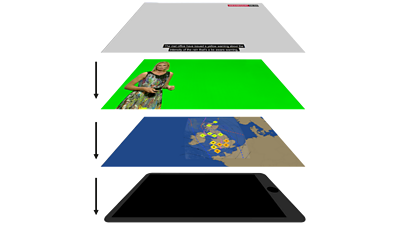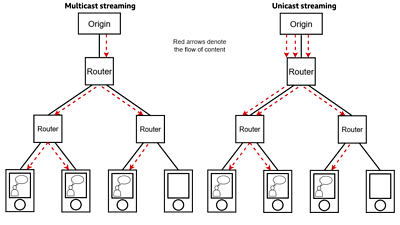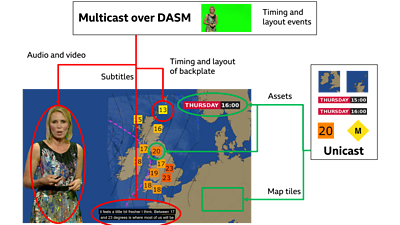
Weβve been recasting our experimental object-based weather forecaster to run as a web app (in the browser and on mobile devices) that will be able to take advantage of new 5G technology to deliver object-based media at scale.
Object-based media for a weather forecast
With object-based media the content (in this instance a weather forecast) is captured as multiple individual media objects and these are distributed separately so that they can be rendered much closer to the end user β this could even be in the end device. This enables each user to have a different experience. In our case, we have the MPEG-DASH video stream of the main presenter and another stream of the sign language presenter, both which are filmed with a green screen, and are distributed in a pseudo-live manner. We also have the background weather map; this is built from several tiled images which are fetched from a server when the app or website is loaded. These are rendered by the end userβs device, using the Mercator projection to achieve a curved map. Since the weather map is rendered on the device, we can easily insert weather icons and personalised images of the location of the userβs friends at run time. The timing and location of the icons on the weather map is controlled by events bundled into the MPEG-DASH video streams. In the future, these events might be generated βon-the-flyβ by the presenter pressing a button!

ΒιΆΉΤΌΕΔ R&D - Object-Based Media
ΒιΆΉΤΌΕΔ R&D - Forecaster: Our Experimental Object-Based Weather Forecast
These objects are sent independently to the end userβs device, where they are rendered as a series of layers, each layer consisting of an HTML5 canvas, using our . The composition of these layers, as well as the nature and location of the objects, is defined in a configuration file. On startup, the app requests the configuration file from a server. The server recognises the end userβs device and chooses a configuration file suited to the particular needs of that device β for example, a low powered device might choose a lower resolution of images and a less computationally expensive layout. This object-based approach, controlled by a dynamic configuration file, is very powerful and achieves an enhanced audio/video media experience in which the presentation of the content can adapt to the userβs environment, the userβs preferences, the deviceβs capabilities and includes personalisation. However, since we are delivering multiple objects where previously we would have only delivered one (the video), getting this high-quality personalised content to many users at scale has a significant effect on the network load when using conventional IP unicast streaming techniques.

Efficient delivery at scale using multicast
We solve this problem by using a hybrid of multicast and unicast. Unicast is the traditional method of IP streaming delivery in which a separate stream is delivered to each user, so if there are a hundred simultaneous users then the same content is sent out one hundred times. This duplication wastes a lot of capacity in networks today. Multicast delivery is an alternative to this for live streams, in which only one stream of content is transmitted, and this is replicated by the network routers themselves. This means that multicast delivery can be significantly more efficient than unicast delivery when many users want to consume the same stream at the same time, since unicast delivery scales in a linear fashion with the number of users. For this reason, commonly used and/or bandwidth-heavy objects are best delivered over a multicast path, whilst the personalisation and/or bandwidth-light objects are better delivered over unicast.

In our Forecaster5G demonstrator we have chosen to deliver the MPEG-DASH video streams over multicast since they are both a significant load on the network and most people want to consume the main presenter video, whilst the images, including those used for personalisation, are delivered over unicast. Importantly, the delivery method is entirely opaque to the user β they will have the same rich object-based experience regardless!

In the Forecaster5G prototype, the multicast MPEG-DASH video is delivered by our (Dynamic Adaptive Streaming over IP Multicast (DASM) system). The DASM Head-end system is located at the ΒιΆΉΤΌΕΔ and transmits the media objects as multicast HTTP resources. These are received by a DASM Client Proxy, which reconstructs the media objects from the received multicast streams. Any multicast packet loss is repaired transparently using the unicast path. The media objects are then delivered to a conventional MPEG DASH player in the end userβs device via unicast.
Demonstrating the app
This work was done as part of 5G-Xcast, a 5GPPP Phase II project focussed on broadcast and multicast communication using 5G. The finale of the project was to demonstrate this app, along with other outputs from the project, at in Valencia. This is an annual conference in the field of telecommunications, that was centred around 5G in 2019.
Working with the 5G Innovation Centre
As part of the , we worked with the to test the hypothesis that the network load when linearly using unicast delivery scales with the number of end-user devices, whilst multicast delivery is much flatter. The architectural diagram shows our prototype deployment, in which the ΒιΆΉΤΌΕΔ is the content provider and the 5GIC is the network operator. We measured the network load (in bits per second) when using multicast delivery for the MPEG-DASH video, versus using unicast delivery, for one, two, three, four and five devices. The results, which can be seen in the following table, supported our hypothesis.


Conclusion
Object-based media has the potential to deliver rich and personalised media experiences over IP. We have worked hard to overcome one of the fundamental problems of broadcasting object-based media over the Internet (that of the network load when delivering multiple objects to many end-user devices), by taking advantage of future expected advances in 5G core architecture that will allow us to use multicast to efficiently deliver commonly used and/or bandwidth-heavy content.
- -
- ΒιΆΉΤΌΕΔ R&D - All of our articles on 4G and 5G including:
- ΒιΆΉΤΌΕΔ R&D - Broadcasting Over 5G - Delivering Live Radio to Orkney
- ΒιΆΉΤΌΕΔ R&D - 4G & 5G Broadcast
- ΒιΆΉΤΌΕΔ R&D - 5G Trials - Streaming AR and VR Experiences on Mobile
- ΒιΆΉΤΌΕΔ R&D - 5G Smart Tourism Trial at the Roman Baths
- ΒιΆΉΤΌΕΔ R&D - New Content Experiences over 5G Fixed Wireless Access
- ΒιΆΉΤΌΕΔ R&D - New Audience Experiences for Mobile Devices
- ΒιΆΉΤΌΕΔ R&D - Unlocking the Potential of 5G for Content Production
- ΒιΆΉΤΌΕΔ R&D - Building our own 5G Broadcast Modem
- ΒιΆΉΤΌΕΔ R&D - TV Over Mobile Networks - ΒιΆΉΤΌΕΔ R&D at the 3GPP
- ΒιΆΉΤΌΕΔ R&D - 4G Broadcast for the Commonwealth Games 2014
- ΒιΆΉΤΌΕΔ R&D - 4G Broadcast technology trial at Wembley 2015 FA Cup Final
- ΒιΆΉΤΌΕΔ R&D - 4G Broadcast: Can LTE eMBMS Help Address the Demand for Mobile Video?
- ΒιΆΉΤΌΕΔ R&D - Broadcast Wi-Fi

